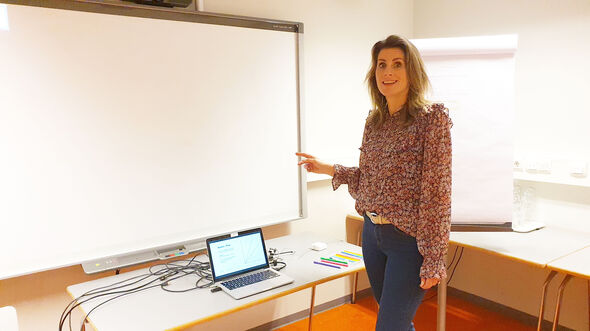Cursor goes course-hopping | Flow
Since no one at TU/e is ever too old to learn, we’re always open to a good course. This time, Cursor attended ‘Flow at your work,’ a course organized by TU/e’s Learning & Development Support and taught by independent career coach Daniëlle Bax. She gives us the following assignment: “Work at having fun today!”
In order to find out what brings you joy at work, or how to rediscover it, you need to identify the tasks that make you happy. Today (Thursday, 2 March, ed.) the very act of following this workshop makes me happy, because it offers me more than just dry information. We’re asked to carry out an assignment and to complete an exercise where we have to fill in the blanks. And we won’t leave this boring meeting room in De Zwarte Doos where daylight doesn’t enter until we’ve made a personal action plan. But more about that later.
‘We’ refers to three participants. A quality assurance officer, an educational advisor and a journalist. All three of us just want to become a bit more satisfied in our job. It’s not that we’re complaining, we just feel that there’s some room for improvement. But what kind of improvement? We don’t know the answer to that question yet, otherwise we would have made some changes by now.
Listing tasks
Daniëlle Bax teaches us that it’s important to know the answer to the following question: ‘where does my circle of influence lie?’ But first, she puts us to work. She asks us to list all our tasks and rate them based on the challenge they present and our personal skills. In other words: how difficult are they and how good am I at carrying them out, I say to myself.
I quickly write down the first things that come to mind: starting a background story, completing a background story, writing brief news items, writing personal interviews, being responsible for online content, sending newsletters, taking care of narrowcasting, taking part in meetings, recruiting a team of student editors. I then need to rate these tasks – with grades – in a chart. The y-axis represents the challenges these tasks present, and the x-axis indicates how skillful I am at carrying them out.
And what does this chart show? It turns out that most of my tasks are in the range of flow. One task causes much stress, another one causes boredom, but I can identify the other ones as flow. What does that mean exactly? Bax lets us say it for ourselves: “Flow is when you concentrate on your work without being distracted, which increases your performance.” The filling in the blanks exercise shows that we are in a flow when tension and stress are in balance with control and boredom. Too much stress increases the risk of a burnout, too much boredom makes you vulnerable to a boreout. “The symptoms are the same,” Bax says, “feeling tired, problems with concentration, physical ailments, short fuse.”
Getting to work
Since there are only three of us, we’re fortunate enough to talk more in detail about a case together. The other two women, and the coach, help me as I try to put into words what it is that bothers me. The task I have problems with – setting up a team consisting of students who want to write for Cursor – isn’t entirely clear. As a result, I don’t feel like doing it, which is why I put it at the bottom of my list of priorities. And even though no one takes me to task for it, I wouldn’t dream of waking up a sleeping dog. But the fact that I can’t complete this task eats away at me.
And so, I decide to make an action plan. I start with asking my colleagues if I can spend a fixed time of my work week without interruption trying to clarify my task of putting together a student editor team until I feel satisfied. Getting to work on this task lies in my circle of influence, because my manager and I agreed on the final goal some time ago.
And TU/e will also be happy if this gets me ‘in my flow.’ Because satisfied employees feel happier about their job, are more focused and have more innovative strength, which allows them to collaborate more effectively and to focus on students more. At least, that’s what it says on one of one Bax’s slides, if we get a short glance of them. The PowerPoint presentation doesn’t work properly; the HMDI cable hasn’t quite found its flow yet.
In the ‘Cursor takes a course’ feature, our editors will take part in the various training sessions, courses and workshops that TU/e offers throughout the year with the aim of allowing students and staff members to increase their knowledge and skills in a variety of fields. If you happen to offer a course, training session or workshop yourself that might be of interest to this feature, or if you know of any such event, don’t hesitate to contact Cursor’s editorial board.



Discussion